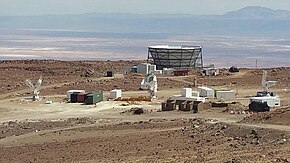Simons Observatory
 The site of the future Simons Observatory, with the Simons Array, Atacama Cosmology Telescope and POLARBEAR. | |
| Alternative names | Observatorio Simons |
|---|---|
| Location | Atacama Desert |
| Coordinates | 22°57′31″S 67°47′15″W / 22.9586°S 67.7875°W |
| Altitude | 5,200 m (17,100 ft) |
| Website | simonsobservatory |
| Commercial telescopes | |
| | |
The Simons Observatory will be located in the high Atacama Desert in Northern Chile inside the Chajnator Science Preserve, at an altitude of 5,200 meters (17,000 ft). The Atacama Cosmology Telescope (ACT) and the Simons Array[1] are currently making observations of the Cosmic Microwave Background. Their goals are to study how the universe began, what it is made of, and how it evolved to its current state. The Simons Observatory will add to these several new telescopes and new cameras with state of the art detector arrays. This has been made possible by a combined $40.1 million grant from the Simons Foundation and a number of participating universities.[2][3][4]
The observatory has begun the design and development of a large (6 meter) diameter telescope.[5] It is envisaged that one of its telescopes would be a precursor for an element of the proposed CMB-S4 array.[6][7][8]
See also
References
- ^ Suzuki, A; Ade, P; Akiba, Y; Aleman, C; Arnold, K; Baccigalupi, C; Barch, B; Barron, D; Bender, A; Boettger, D; Borrill, J; Chapman, S; Chinone, Y; Cukierman, A; Dobbs, M; Ducout, A; Dunner, R; Elleflot, T; Errard, J; Fabbian, G; Feeney, S; Feng, C; Fujino, T; Fuller, G; Gilbert, A; Goeckner-Wald, N; Groh, J; De Haan, T; Hall, G; et al. (2015). "The POLARBEAR-2 and the Simons Array Experiment". Journal of Low Temperature Physics. 184 (3–4): 805. arXiv:1512.07299. doi:10.1007/s10909-015-1425-4.
- ^ Scientific American. "Hunt for Big Bang Gravitational Waves Gets $40-Million Boost". scientificamerican.com. Retrieved 5 March 2017.
- ^ Photonics Media. "Simons Observatory Receives $40M in Funding to Advance Telescopes, Detectors". photonics.com.
- ^ Space Daily. "Simons observatory will investigate the early universe". spacedaily.com. Retrieved 5 March 2017.
- ^ "UC San Diego Signs On to Study Cosmos with Massive New Telescope in South America". ucsdnews.ucsd.edu. Retrieved 2017-12-21.
- ^ Inside Science. "Looking Deeper Into Our Cosmic Past Scientists reveal plans for future experiments to study the faint remnants left behind by the Big Bang". insidescience.org. Retrieved 5 March 2017.
- ^ Symmetry. "2016 year in particle physics". symmetrymagazine.org. Retrieved 5 March 2017.
- ^ Cartlidge, Edwin (2017). "Huge microwave observatory to search for cosmic inflation". Nature. doi:10.1038/nature.2017.22920.

